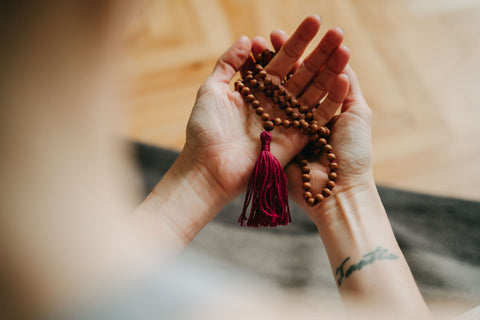
What is Japa mala and how to practice Japa technique?
Share
What is Japa mala?
Japa Mala, commonly referred to as simply "Mala," is a string of prayer beads used in various spiritual practices, particularly in Hinduism, Buddhism, Jainism, and Sikhism. The term "japa" refers to the meditative repetition of a mantra or a divine name.
A traditional Japa Mala typically consists of 108 beads, although variations with different numbers like 27 or 54 beads are also common. The number 108 holds significance in many spiritual traditions. Each bead is counted as a repetition of a mantra or a prayer, aiding the practitioner in maintaining focus and concentration during meditation or prayer.
The Mala usually features a larger bead called the "guru" bead, which represents the connection to the divine or the spiritual teacher. The practitioner starts and ends the meditation or prayer session at this bead, never crossing over it.

How to practice Japa practice with a Japa mala?
- Choose a Mantra: Select a mantra or sacred phrase that holds significance for you. This could be a word or phrase from your spiritual tradition, a personal affirmation, or a divine name. You can use a universal mantra ''OM'' or ''SO HUM'' ( I am that).
- Sit in a Comfortable Position: Find a quiet and comfortable place to sit where you won't be disturbed. You can sit on a cushion, chair, or any supportive surface. Make sure your spine is comfortably straight.
- Hold the Mala: Hold the Japa Mala in your right hand, draped over your middle finger with the beads hanging between your thumb and ring finger.
- Start at the Guru Bead: Begin your practice by holding the first bead next to the guru bead (the larger bead) with your thumb and middle finger.
- Recite the Mantra: As you hold the bead, recite your chosen mantra or prayer softly, either silently or aloud. With each repetition of the mantra, move to the next bead by gently rolling it over your middle finger with your thumb. Continue this process for each bead.
- Maintain Focus: Try to maintain focus on the mantra and the sensation of the beads moving through your fingers. If your mind wanders, gently bring your attention back to the mantra and the present moment.
- Complete the Circumambulation: When you reach the guru bead again after completing all 108 repetitions, you can choose to end your practice or continue for additional rounds. If you wish to continue, do not cross over the guru bead. Instead, turn the Mala around and begin again in the opposite direction.
- Conclude the Practice: When you're ready to conclude your practice, pause for a moment of gratitude or reflection. You can also offer a final prayer or intention.
